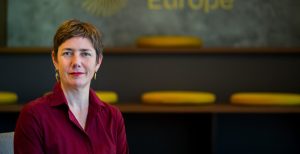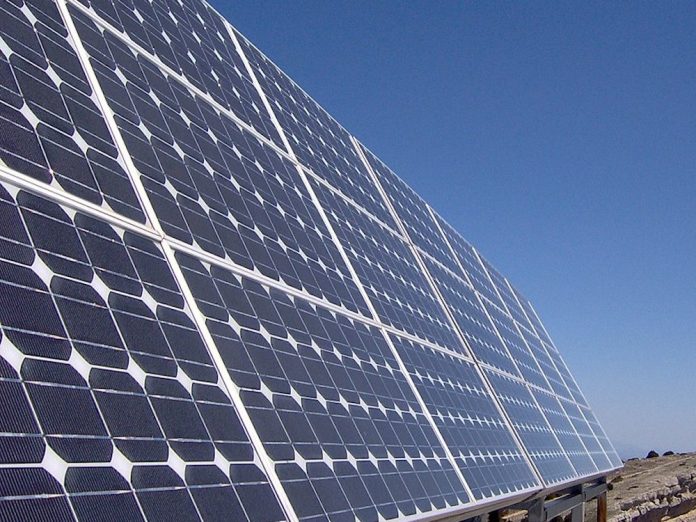All types of photovoltaics that use as little land as possible are good, including floating solar power plants, agrivoltaics and building-integrated photovoltaics, Chief Executive Officer of SolarPower Europe Walburga Hemetsberger said. In an interview with Balkan Green Energy News, she reiterated the call to the European Union to help the domestic industry in the sector.
Solar power plants are synonymous with the energy transition and decarbonization. And vice versa! Photovoltaic units are cheaper and simpler to install than other technologies. They enable individuals, households, small firms and institutions to generate electricity for self-consumption. They are the basis for the electrification of everything.
But the historic expansion in Europe still isn’t mirrored, far from it, by a surge in domestic production of parts from wiring to inverters to solar panels. It means the job is only half done. Manufacturing is essential in terms of employment, technological development and competitiveness.
Balkan Green Energy News sat with SolarPower Europe’s CEO Walburga Hemetsberger, who outlined the industry’s current woes and the tools to overcome them.
In a recent letter to the European Commission, SolarPower Europe warned of the risk of a wave of bankruptcies in the manufacturing segment. You pointed to the sharp drop in the prices of materials and equipment, saying it is hurting producers. Just a little while ago, the issue was the scarcity of materials and equipment and a surge in prices. How did it reverse so fast?
Like with all other green technology sectors, the demand is booming. So there comes a moment when strong investments in production result in overcapacity.
We had some supply chain issues during the pandemic, and then demand got even stronger with the surge in energy prices. So everyone was suddenly scaling up manufacturing capacities. At the same time, wholesalers and installers were building up their stocks, because earlier they experienced shortages.
Then, with inventories filled and overcapacity on the manufacturing side, prices dropped to levels not seen since before the pandemic, including the raw material polysilicon.
In addition, we saw that developers are facing a hard time. The market declined a little bit since the beginning of the third quarter. It all created a perfect storm in a matter of weeks and it’s detrimental for a European industry, to see growth again.
The letter calls for an emergency acquisition of equipment stockpiled in Europe. Who would buy the module inventories and what would be the next step? What is the idea behind the proposal for a solar manufacturing bank?
For example, the European Union could use the newly created Ukraine Facility. It is a fund which is helping to build up Ukraine with green technologies. The stocks would cost EUR 80 million to EUR 100 million. But as European production is still mostly costlier than elsewhere, in the long term we see a need to bridge that gap.
We are proposing to create a solar manufacturing bank. Manufacturers could bid at the platform to sell their equipment. On the other side, offtakers and project developers give offers to buy European modules.
Right now there is a mismatch, but a European fund, for instance the Innovation Fund, could provide financing to bridge the price gap. It would be a very cost-efficient way of subsidizing manufacturing facilities as they are small in size and we need to scale them up.

Photo: A European fund could provide financing to bridge the gap between the prices on the sides of domestic production and demand (SolarPower Europe)
Several technologies and concepts are emerging in the sector. For instance, floating PV, agrivoltaics, building-integrated photovoltaics (BIPV), citizen energy and energy sharing on the distribution grid level… Can they become real energy transition pillars?
All technologies and approaches that use as little land as possible are good. It’s a no-brainer. Floating solar power plants, agri-PV and BIPV are some of the examples.
The European Commission is actually proposing mandatory photovoltaic systems on roofs. You should just use the spaces you have and roofs are the most obvious, as the consumers are right underneath.
Roofs need to be used as much as possible, in the sense that the energy should be shared with others. Furthermore, combinations with heat pumps and electric vehicles enable savings for consumers.
You said that Serbia would be a great place for big manufacturing facilities. What do investors expect?
Europe needs big factories to be able to compete. In particular, with Chinese companies. The sites there can manufacture 5 GW to 10 GW per year. Our goal is to have an annual production capacity of 30 GW per year by 2030.
It requires political support and member states working together. It doesn’t help us to have a small manufacturing site here and another little one there.
We need to see scaling up along the entire value chain, all the phases in manufacturing, and have the whole ecosystem
In Europe we have module manufacturers, mostly assembling solar cells from China. We need to see scaling up along the entire value chain, all the phases in manufacturing, and have the whole ecosystem.
We need to be faster in permitting, too, and provide access to land.
Everyone can seize the opportunity and provide the best framework, the conditions to attract value creation in their country. To create jobs. As long as Serbia provides such conditions, manufacturers would be happy to come here to scale up.
There is political support in Europe to build up manufacturing again. One of the ideas currently discussed within the EU is to make it easier to give state aid to industrial projects. Also, European products could be assigned bonuses under non-price criteria at special auctions.
It’s an opportunity not just to scale up renewables but also produce them.
What would the non-price criteria be?
ESG criteria – environmental, social and governance – is being discussed, for example. We believe we have clear benefits that we can provide with regard to sustainability requirements.
The European Commission is also proposing a resilience criterion, for sectors which are more than 65% dependent on third countries. Solar power and batteries are clearly eligible.
That brings us back to the dependence on Chinese imports and the efforts to reduce it. But can the current ambitions for solar power deployment be materialized at all without equipment from China? Wouldn’t restrictions be counterproductive? Is there a middle ground?
We are importing about 90% of the products that we need for the deployment of solar from China. It is in no one’s interest to slow down the energy transition. Having said that, it is critically important to build up that resilience.
We need a balanced approach, where we are not slowing down the energy transition, but are still helping European manufacturers to scale up and be competitive. We want to have strategic autonomy, which requires a very clear industrial plan. Trade barriers are not the solution to the crisis we see today.






